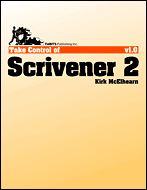 When I saw that there was a Take Control book available for Scrivener 2 I was excited to see if it could help me use Scrivener more effectively. I bought Scrivener back in 2005/6 in the desperate hope that it would help me take control of my own disparate thoughts and work on my doctoral thesis. I found it helpful to start to get a grasp but was not able to really put it to the ultimate use. I collected reference material and built an outline.
When I saw that there was a Take Control book available for Scrivener 2 I was excited to see if it could help me use Scrivener more effectively. I bought Scrivener back in 2005/6 in the desperate hope that it would help me take control of my own disparate thoughts and work on my doctoral thesis. I found it helpful to start to get a grasp but was not able to really put it to the ultimate use. I collected reference material and built an outline.
I completed random short articles and messed about, but I have since wanted to really put Scrivener to the test. I upgraded to version 2 in the last year when I had the chance – the hope still to tame Scrivener and make it work for me…
And then along comes this new Take Control volume. I must be the target for just such a book. I dug in greedily.
One of the first things that strike you is that the text is very hypertextual and presented in a rather referential rather than linear fashion. The book is fulsome. It is strewn with nuggets and within are all the bits and pieces you could want to ‘take control’ of Scrivener. The challenge that I think the author faces comes from the program itself…it is designed to be freeform and take what floats around n one’s creative ether and to try to find a way to take it from a 3D (or maybe more vectored) dimension and flatten it into a 2D structure. This is a monster challenge and it is evident in this book as well. If there is any criticism to be made, it is the hypertextual nature of the book. The intention of the book is to allow for a linear approach, but this necessitates building to detail and starting from a skeletal basis. As a result, there are frequent (too frequent) references to later chapters and sections. Sometimes this seems to get in the way. I think the intention is to allow for absolute novices to use the book as a learning tool but to also allow more advanced users to use it more as a reference source or to focus on an area of specific interest. Such multi-use calls for particularly skilful weaving of the narrative. This is nearly compromised in the case of this book.
What this book takes to use and to really make it sing is the ability to sit down with the program and the book and concentrate with them both for an extended period of time. Kirk McElhearn has committed to producing a fine volume and this also demands a commitment on your part to appreciate it. I applaud the author for the structure of this book. It is very good. What do you see in the program –> let’s try and set up a framework to work with Scrivener –> Here’s how you can systematically do so –> here’s the other stuff you should know about Scrivener that might confound your efforts –> Here’s how you transform what you have into what you need. Chapters start with good summaries of where you are at, anecdotes are sprinkled throughout. It’s all there and more.
Take Control of Scrivener is an invaluable source of information, despite my starting with a criticism of the volume. There are few books to call upon for any extra-manual instruction in Scrivener and the tips and tutorial in this volume are superb and much appreciated. I would recommend this book to any use of Scrivener for honing and perfecting their usage of a powerful writing tool.

